MAED 5352 Patterns and Algebra Module
VerifiedAdded on 2020/04/29
|9
|3255
|43
AI Summary
Contribute Materials
Your contribution can guide someone’s learning journey. Share your
documents today.
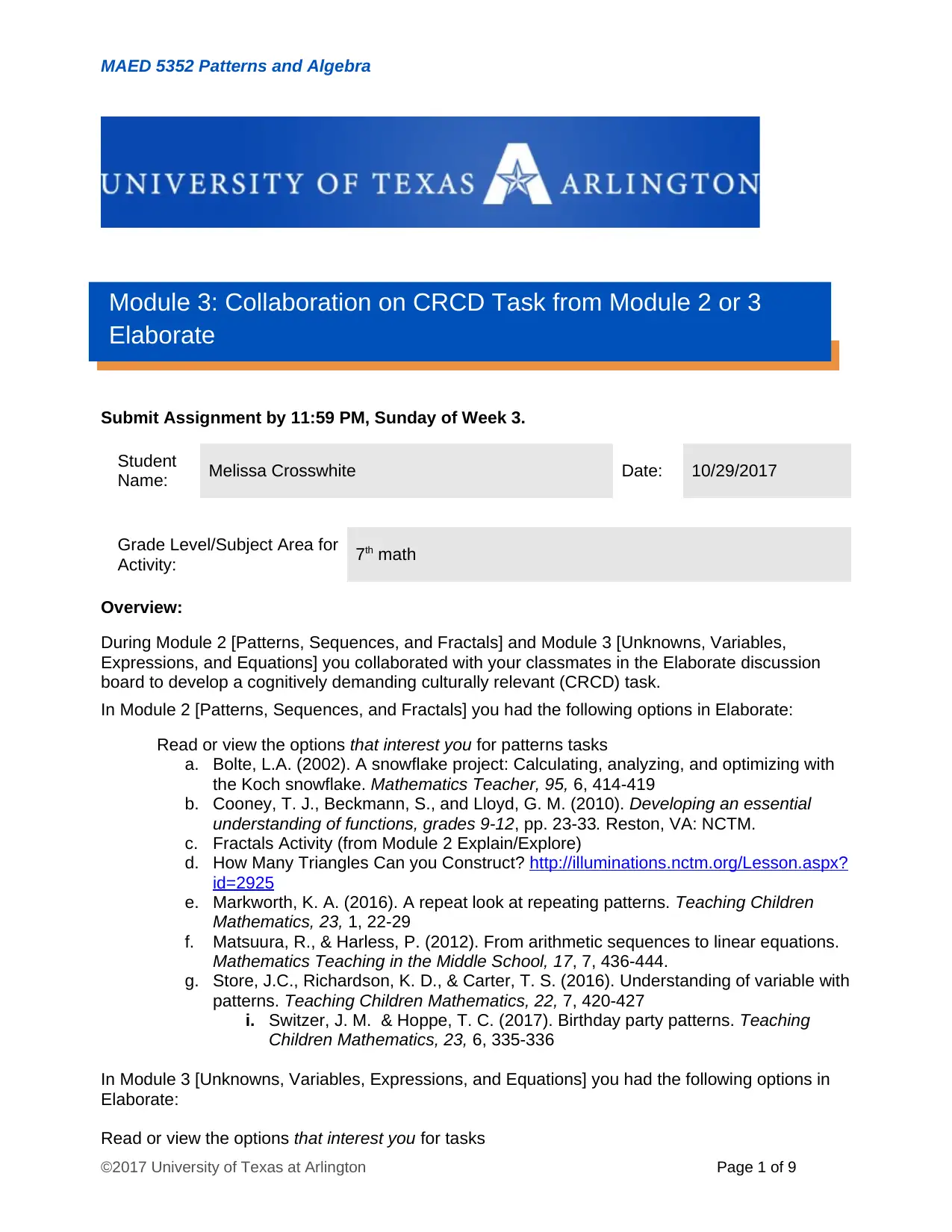
MAED 5352 Patterns and Algebra
Submit Assignment by 11:59 PM, Sunday of Week 3.
Student
Name: Melissa Crosswhite Date: 10/29/2017
Grade Level/Subject Area for
Activity: 7th math
Overview:
During Module 2 [Patterns, Sequences, and Fractals] and Module 3 [Unknowns, Variables,
Expressions, and Equations] you collaborated with your classmates in the Elaborate discussion
board to develop a cognitively demanding culturally relevant (CRCD) task.
In Module 2 [Patterns, Sequences, and Fractals] you had the following options in Elaborate:
Read or view the options that interest you for patterns tasks
a. Bolte, L.A. (2002). A snowflake project: Calculating, analyzing, and optimizing with
the Koch snowflake. Mathematics Teacher, 95, 6, 414-419
b. Cooney, T. J., Beckmann, S., and Lloyd, G. M. (2010). Developing an essential
understanding of functions, grades 9-12, pp. 23-33. Reston, VA: NCTM.
c. Fractals Activity (from Module 2 Explain/Explore)
d. How Many Triangles Can you Construct? http://illuminations.nctm.org/Lesson.aspx?
id=2925
e. Markworth, K. A. (2016). A repeat look at repeating patterns. Teaching Children
Mathematics, 23, 1, 22-29
f. Matsuura, R., & Harless, P. (2012). From arithmetic sequences to linear equations.
Mathematics Teaching in the Middle School, 17, 7, 436-444.
g. Store, J.C., Richardson, K. D., & Carter, T. S. (2016). Understanding of variable with
patterns. Teaching Children Mathematics, 22, 7, 420-427
i. Switzer, J. M. & Hoppe, T. C. (2017). Birthday party patterns. Teaching
Children Mathematics, 23, 6, 335-336
In Module 3 [Unknowns, Variables, Expressions, and Equations] you had the following options in
Elaborate:
Read or view the options that interest you for tasks
©2017 University of Texas at Arlington Page 1 of 9
Module 3: Collaboration on CRCD Task from Module 2 or 3
Elaborate
Submit Assignment by 11:59 PM, Sunday of Week 3.
Student
Name: Melissa Crosswhite Date: 10/29/2017
Grade Level/Subject Area for
Activity: 7th math
Overview:
During Module 2 [Patterns, Sequences, and Fractals] and Module 3 [Unknowns, Variables,
Expressions, and Equations] you collaborated with your classmates in the Elaborate discussion
board to develop a cognitively demanding culturally relevant (CRCD) task.
In Module 2 [Patterns, Sequences, and Fractals] you had the following options in Elaborate:
Read or view the options that interest you for patterns tasks
a. Bolte, L.A. (2002). A snowflake project: Calculating, analyzing, and optimizing with
the Koch snowflake. Mathematics Teacher, 95, 6, 414-419
b. Cooney, T. J., Beckmann, S., and Lloyd, G. M. (2010). Developing an essential
understanding of functions, grades 9-12, pp. 23-33. Reston, VA: NCTM.
c. Fractals Activity (from Module 2 Explain/Explore)
d. How Many Triangles Can you Construct? http://illuminations.nctm.org/Lesson.aspx?
id=2925
e. Markworth, K. A. (2016). A repeat look at repeating patterns. Teaching Children
Mathematics, 23, 1, 22-29
f. Matsuura, R., & Harless, P. (2012). From arithmetic sequences to linear equations.
Mathematics Teaching in the Middle School, 17, 7, 436-444.
g. Store, J.C., Richardson, K. D., & Carter, T. S. (2016). Understanding of variable with
patterns. Teaching Children Mathematics, 22, 7, 420-427
i. Switzer, J. M. & Hoppe, T. C. (2017). Birthday party patterns. Teaching
Children Mathematics, 23, 6, 335-336
In Module 3 [Unknowns, Variables, Expressions, and Equations] you had the following options in
Elaborate:
Read or view the options that interest you for tasks
©2017 University of Texas at Arlington Page 1 of 9
Module 3: Collaboration on CRCD Task from Module 2 or 3
Elaborate
Secure Best Marks with AI Grader
Need help grading? Try our AI Grader for instant feedback on your assignments.
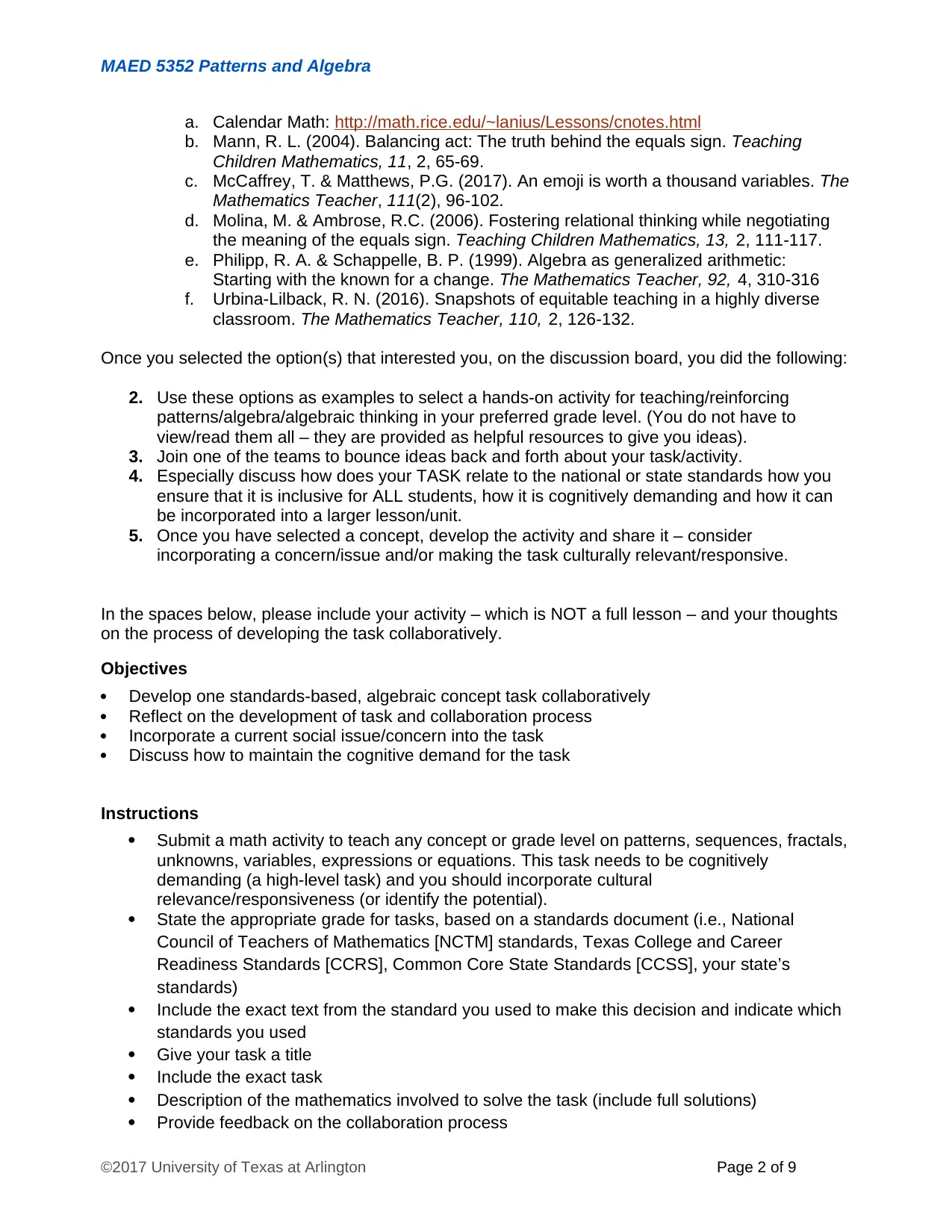
MAED 5352 Patterns and Algebra
a. Calendar Math: http://math.rice.edu/~lanius/Lessons/cnotes.html
b. Mann, R. L. (2004). Balancing act: The truth behind the equals sign. Teaching
Children Mathematics, 11, 2, 65-69.
c. McCaffrey, T. & Matthews, P.G. (2017). An emoji is worth a thousand variables. The
Mathematics Teacher, 111(2), 96-102.
d. Molina, M. & Ambrose, R.C. (2006). Fostering relational thinking while negotiating
the meaning of the equals sign. Teaching Children Mathematics, 13, 2, 111-117.
e. Philipp, R. A. & Schappelle, B. P. (1999). Algebra as generalized arithmetic:
Starting with the known for a change. The Mathematics Teacher, 92, 4, 310-316
f. Urbina-Lilback, R. N. (2016). Snapshots of equitable teaching in a highly diverse
classroom. The Mathematics Teacher, 110, 2, 126-132.
Once you selected the option(s) that interested you, on the discussion board, you did the following:
2. Use these options as examples to select a hands-on activity for teaching/reinforcing
patterns/algebra/algebraic thinking in your preferred grade level. (You do not have to
view/read them all – they are provided as helpful resources to give you ideas).
3. Join one of the teams to bounce ideas back and forth about your task/activity.
4. Especially discuss how does your TASK relate to the national or state standards how you
ensure that it is inclusive for ALL students, how it is cognitively demanding and how it can
be incorporated into a larger lesson/unit.
5. Once you have selected a concept, develop the activity and share it – consider
incorporating a concern/issue and/or making the task culturally relevant/responsive.
In the spaces below, please include your activity – which is NOT a full lesson – and your thoughts
on the process of developing the task collaboratively.
Objectives
Develop one standards-based, algebraic concept task collaboratively
Reflect on the development of task and collaboration process
Incorporate a current social issue/concern into the task
Discuss how to maintain the cognitive demand for the task
Instructions
Submit a math activity to teach any concept or grade level on patterns, sequences, fractals,
unknowns, variables, expressions or equations. This task needs to be cognitively
demanding (a high-level task) and you should incorporate cultural
relevance/responsiveness (or identify the potential).
State the appropriate grade for tasks, based on a standards document (i.e., National
Council of Teachers of Mathematics [NCTM] standards, Texas College and Career
Readiness Standards [CCRS], Common Core State Standards [CCSS], your state’s
standards)
Include the exact text from the standard you used to make this decision and indicate which
standards you used
Give your task a title
Include the exact task
Description of the mathematics involved to solve the task (include full solutions)
Provide feedback on the collaboration process
©2017 University of Texas at Arlington Page 2 of 9
a. Calendar Math: http://math.rice.edu/~lanius/Lessons/cnotes.html
b. Mann, R. L. (2004). Balancing act: The truth behind the equals sign. Teaching
Children Mathematics, 11, 2, 65-69.
c. McCaffrey, T. & Matthews, P.G. (2017). An emoji is worth a thousand variables. The
Mathematics Teacher, 111(2), 96-102.
d. Molina, M. & Ambrose, R.C. (2006). Fostering relational thinking while negotiating
the meaning of the equals sign. Teaching Children Mathematics, 13, 2, 111-117.
e. Philipp, R. A. & Schappelle, B. P. (1999). Algebra as generalized arithmetic:
Starting with the known for a change. The Mathematics Teacher, 92, 4, 310-316
f. Urbina-Lilback, R. N. (2016). Snapshots of equitable teaching in a highly diverse
classroom. The Mathematics Teacher, 110, 2, 126-132.
Once you selected the option(s) that interested you, on the discussion board, you did the following:
2. Use these options as examples to select a hands-on activity for teaching/reinforcing
patterns/algebra/algebraic thinking in your preferred grade level. (You do not have to
view/read them all – they are provided as helpful resources to give you ideas).
3. Join one of the teams to bounce ideas back and forth about your task/activity.
4. Especially discuss how does your TASK relate to the national or state standards how you
ensure that it is inclusive for ALL students, how it is cognitively demanding and how it can
be incorporated into a larger lesson/unit.
5. Once you have selected a concept, develop the activity and share it – consider
incorporating a concern/issue and/or making the task culturally relevant/responsive.
In the spaces below, please include your activity – which is NOT a full lesson – and your thoughts
on the process of developing the task collaboratively.
Objectives
Develop one standards-based, algebraic concept task collaboratively
Reflect on the development of task and collaboration process
Incorporate a current social issue/concern into the task
Discuss how to maintain the cognitive demand for the task
Instructions
Submit a math activity to teach any concept or grade level on patterns, sequences, fractals,
unknowns, variables, expressions or equations. This task needs to be cognitively
demanding (a high-level task) and you should incorporate cultural
relevance/responsiveness (or identify the potential).
State the appropriate grade for tasks, based on a standards document (i.e., National
Council of Teachers of Mathematics [NCTM] standards, Texas College and Career
Readiness Standards [CCRS], Common Core State Standards [CCSS], your state’s
standards)
Include the exact text from the standard you used to make this decision and indicate which
standards you used
Give your task a title
Include the exact task
Description of the mathematics involved to solve the task (include full solutions)
Provide feedback on the collaboration process
©2017 University of Texas at Arlington Page 2 of 9
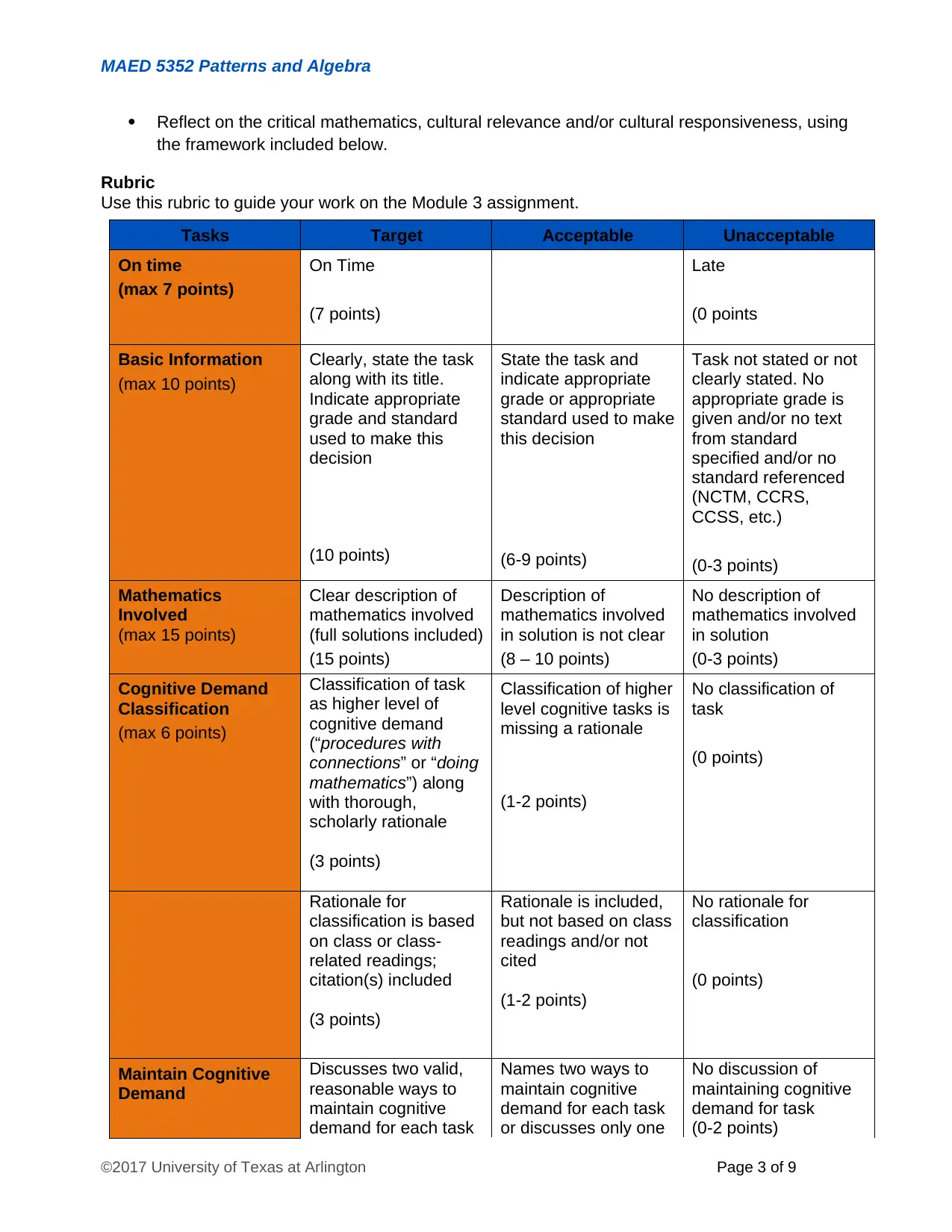
MAED 5352 Patterns and Algebra
Reflect on the critical mathematics, cultural relevance and/or cultural responsiveness, using
the framework included below.
Rubric
Use this rubric to guide your work on the Module 3 assignment.
Tasks Target Acceptable Unacceptable
On time
(max 7 points)
On Time
(7 points)
Late
(0 points
Basic Information
(max 10 points)
Clearly, state the task
along with its title.
Indicate appropriate
grade and standard
used to make this
decision
(10 points)
State the task and
indicate appropriate
grade or appropriate
standard used to make
this decision
(6-9 points)
Task not stated or not
clearly stated. No
appropriate grade is
given and/or no text
from standard
specified and/or no
standard referenced
(NCTM, CCRS,
CCSS, etc.)
(0-3 points)
Mathematics
Involved
(max 15 points)
Clear description of
mathematics involved
(full solutions included)
(15 points)
Description of
mathematics involved
in solution is not clear
(8 – 10 points)
No description of
mathematics involved
in solution
(0-3 points)
Cognitive Demand
Classification
(max 6 points)
Classification of task
as higher level of
cognitive demand
(“procedures with
connections” or “doing
mathematics”) along
with thorough,
scholarly rationale
(3 points)
Classification of higher
level cognitive tasks is
missing a rationale
(1-2 points)
No classification of
task
(0 points)
Rationale for
classification is based
on class or class-
related readings;
citation(s) included
(3 points)
Rationale is included,
but not based on class
readings and/or not
cited
(1-2 points)
No rationale for
classification
(0 points)
Maintain Cognitive
Demand
Discusses two valid,
reasonable ways to
maintain cognitive
demand for each task
Names two ways to
maintain cognitive
demand for each task
or discusses only one
No discussion of
maintaining cognitive
demand for task
(0-2 points)
©2017 University of Texas at Arlington Page 3 of 9
Reflect on the critical mathematics, cultural relevance and/or cultural responsiveness, using
the framework included below.
Rubric
Use this rubric to guide your work on the Module 3 assignment.
Tasks Target Acceptable Unacceptable
On time
(max 7 points)
On Time
(7 points)
Late
(0 points
Basic Information
(max 10 points)
Clearly, state the task
along with its title.
Indicate appropriate
grade and standard
used to make this
decision
(10 points)
State the task and
indicate appropriate
grade or appropriate
standard used to make
this decision
(6-9 points)
Task not stated or not
clearly stated. No
appropriate grade is
given and/or no text
from standard
specified and/or no
standard referenced
(NCTM, CCRS,
CCSS, etc.)
(0-3 points)
Mathematics
Involved
(max 15 points)
Clear description of
mathematics involved
(full solutions included)
(15 points)
Description of
mathematics involved
in solution is not clear
(8 – 10 points)
No description of
mathematics involved
in solution
(0-3 points)
Cognitive Demand
Classification
(max 6 points)
Classification of task
as higher level of
cognitive demand
(“procedures with
connections” or “doing
mathematics”) along
with thorough,
scholarly rationale
(3 points)
Classification of higher
level cognitive tasks is
missing a rationale
(1-2 points)
No classification of
task
(0 points)
Rationale for
classification is based
on class or class-
related readings;
citation(s) included
(3 points)
Rationale is included,
but not based on class
readings and/or not
cited
(1-2 points)
No rationale for
classification
(0 points)
Maintain Cognitive
Demand
Discusses two valid,
reasonable ways to
maintain cognitive
demand for each task
Names two ways to
maintain cognitive
demand for each task
or discusses only one
No discussion of
maintaining cognitive
demand for task
(0-2 points)
©2017 University of Texas at Arlington Page 3 of 9
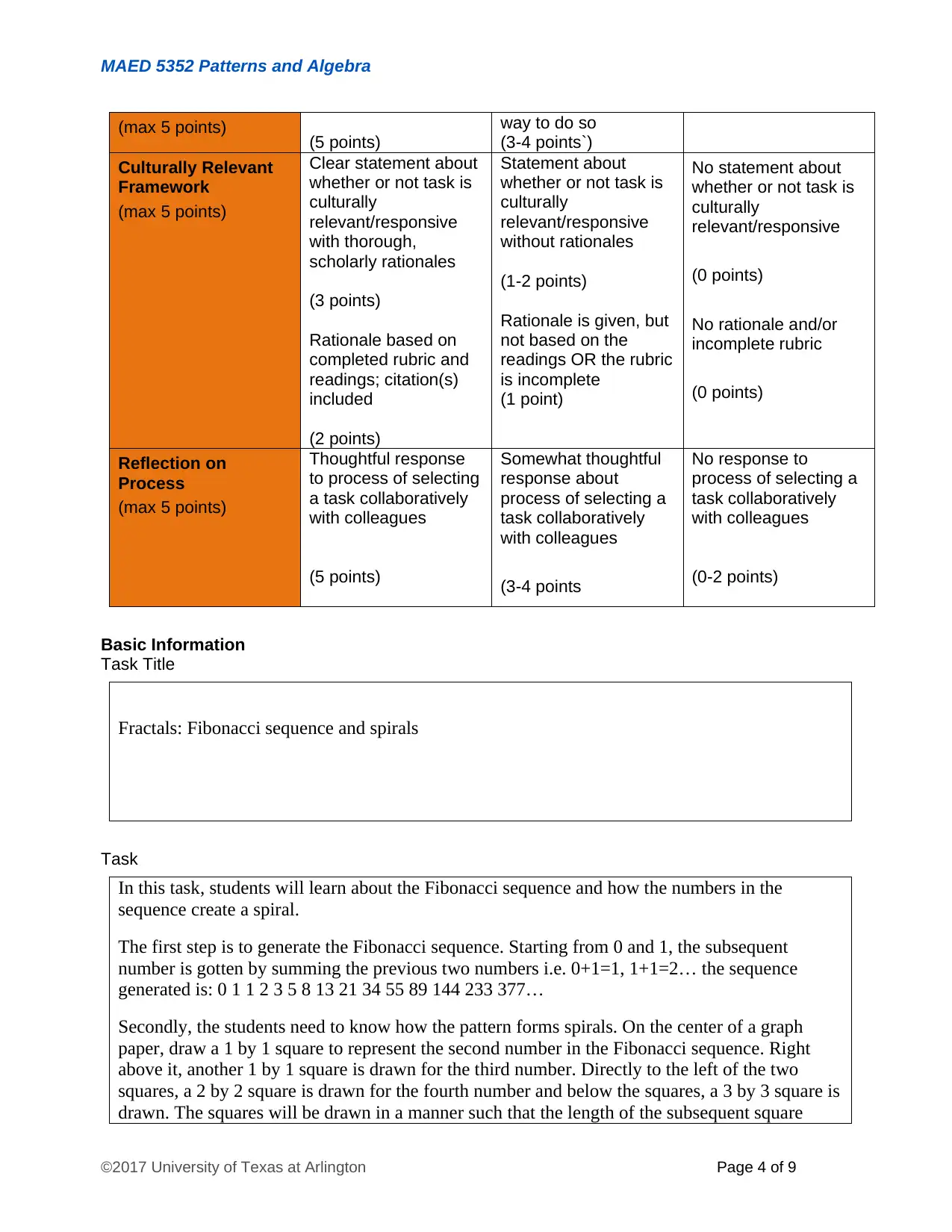
MAED 5352 Patterns and Algebra
(max 5 points) (5 points)
way to do so
(3-4 points`)
Culturally Relevant
Framework
(max 5 points)
Clear statement about
whether or not task is
culturally
relevant/responsive
with thorough,
scholarly rationales
(3 points)
Rationale based on
completed rubric and
readings; citation(s)
included
(2 points)
Statement about
whether or not task is
culturally
relevant/responsive
without rationales
(1-2 points)
Rationale is given, but
not based on the
readings OR the rubric
is incomplete
(1 point)
No statement about
whether or not task is
culturally
relevant/responsive
(0 points)
No rationale and/or
incomplete rubric
(0 points)
Reflection on
Process
(max 5 points)
Thoughtful response
to process of selecting
a task collaboratively
with colleagues
(5 points)
Somewhat thoughtful
response about
process of selecting a
task collaboratively
with colleagues
(3-4 points
No response to
process of selecting a
task collaboratively
with colleagues
(0-2 points)
Basic Information
Task Title
Fractals: Fibonacci sequence and spirals
Task
In this task, students will learn about the Fibonacci sequence and how the numbers in the
sequence create a spiral.
The first step is to generate the Fibonacci sequence. Starting from 0 and 1, the subsequent
number is gotten by summing the previous two numbers i.e. 0+1=1, 1+1=2… the sequence
generated is: 0 1 1 2 3 5 8 13 21 34 55 89 144 233 377…
Secondly, the students need to know how the pattern forms spirals. On the center of a graph
paper, draw a 1 by 1 square to represent the second number in the Fibonacci sequence. Right
above it, another 1 by 1 square is drawn for the third number. Directly to the left of the two
squares, a 2 by 2 square is drawn for the fourth number and below the squares, a 3 by 3 square is
drawn. The squares will be drawn in a manner such that the length of the subsequent square
©2017 University of Texas at Arlington Page 4 of 9
(max 5 points) (5 points)
way to do so
(3-4 points`)
Culturally Relevant
Framework
(max 5 points)
Clear statement about
whether or not task is
culturally
relevant/responsive
with thorough,
scholarly rationales
(3 points)
Rationale based on
completed rubric and
readings; citation(s)
included
(2 points)
Statement about
whether or not task is
culturally
relevant/responsive
without rationales
(1-2 points)
Rationale is given, but
not based on the
readings OR the rubric
is incomplete
(1 point)
No statement about
whether or not task is
culturally
relevant/responsive
(0 points)
No rationale and/or
incomplete rubric
(0 points)
Reflection on
Process
(max 5 points)
Thoughtful response
to process of selecting
a task collaboratively
with colleagues
(5 points)
Somewhat thoughtful
response about
process of selecting a
task collaboratively
with colleagues
(3-4 points
No response to
process of selecting a
task collaboratively
with colleagues
(0-2 points)
Basic Information
Task Title
Fractals: Fibonacci sequence and spirals
Task
In this task, students will learn about the Fibonacci sequence and how the numbers in the
sequence create a spiral.
The first step is to generate the Fibonacci sequence. Starting from 0 and 1, the subsequent
number is gotten by summing the previous two numbers i.e. 0+1=1, 1+1=2… the sequence
generated is: 0 1 1 2 3 5 8 13 21 34 55 89 144 233 377…
Secondly, the students need to know how the pattern forms spirals. On the center of a graph
paper, draw a 1 by 1 square to represent the second number in the Fibonacci sequence. Right
above it, another 1 by 1 square is drawn for the third number. Directly to the left of the two
squares, a 2 by 2 square is drawn for the fourth number and below the squares, a 3 by 3 square is
drawn. The squares will be drawn in a manner such that the length of the subsequent square
©2017 University of Texas at Arlington Page 4 of 9
Secure Best Marks with AI Grader
Need help grading? Try our AI Grader for instant feedback on your assignments.
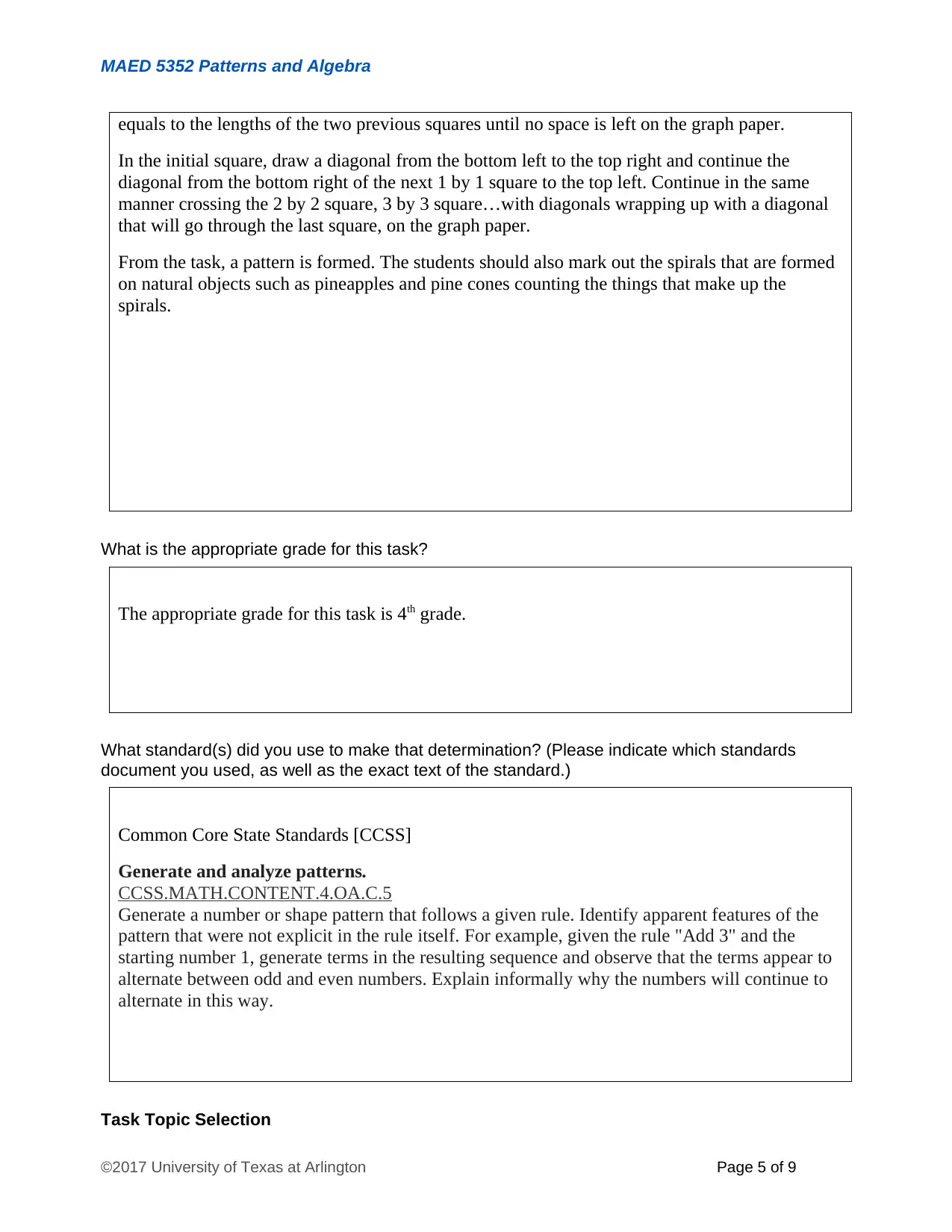
MAED 5352 Patterns and Algebra
equals to the lengths of the two previous squares until no space is left on the graph paper.
In the initial square, draw a diagonal from the bottom left to the top right and continue the
diagonal from the bottom right of the next 1 by 1 square to the top left. Continue in the same
manner crossing the 2 by 2 square, 3 by 3 square…with diagonals wrapping up with a diagonal
that will go through the last square, on the graph paper.
From the task, a pattern is formed. The students should also mark out the spirals that are formed
on natural objects such as pineapples and pine cones counting the things that make up the
spirals.
What is the appropriate grade for this task?
The appropriate grade for this task is 4th grade.
What standard(s) did you use to make that determination? (Please indicate which standards
document you used, as well as the exact text of the standard.)
Common Core State Standards [CCSS]
Generate and analyze patterns.
CCSS.MATH.CONTENT.4.OA.C.5
Generate a number or shape pattern that follows a given rule. Identify apparent features of the
pattern that were not explicit in the rule itself. For example, given the rule "Add 3" and the
starting number 1, generate terms in the resulting sequence and observe that the terms appear to
alternate between odd and even numbers. Explain informally why the numbers will continue to
alternate in this way.
Task Topic Selection
©2017 University of Texas at Arlington Page 5 of 9
equals to the lengths of the two previous squares until no space is left on the graph paper.
In the initial square, draw a diagonal from the bottom left to the top right and continue the
diagonal from the bottom right of the next 1 by 1 square to the top left. Continue in the same
manner crossing the 2 by 2 square, 3 by 3 square…with diagonals wrapping up with a diagonal
that will go through the last square, on the graph paper.
From the task, a pattern is formed. The students should also mark out the spirals that are formed
on natural objects such as pineapples and pine cones counting the things that make up the
spirals.
What is the appropriate grade for this task?
The appropriate grade for this task is 4th grade.
What standard(s) did you use to make that determination? (Please indicate which standards
document you used, as well as the exact text of the standard.)
Common Core State Standards [CCSS]
Generate and analyze patterns.
CCSS.MATH.CONTENT.4.OA.C.5
Generate a number or shape pattern that follows a given rule. Identify apparent features of the
pattern that were not explicit in the rule itself. For example, given the rule "Add 3" and the
starting number 1, generate terms in the resulting sequence and observe that the terms appear to
alternate between odd and even numbers. Explain informally why the numbers will continue to
alternate in this way.
Task Topic Selection
©2017 University of Texas at Arlington Page 5 of 9
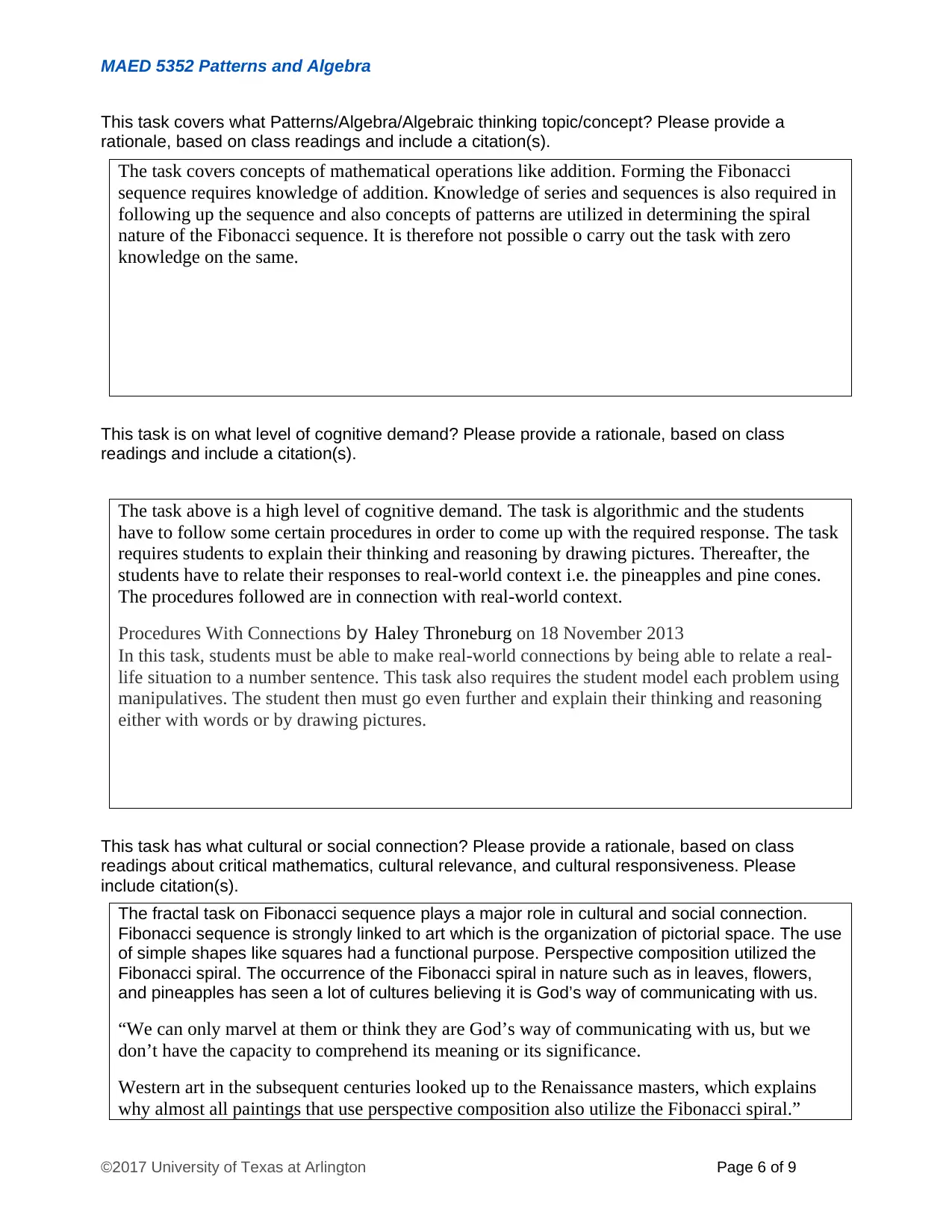
MAED 5352 Patterns and Algebra
This task covers what Patterns/Algebra/Algebraic thinking topic/concept? Please provide a
rationale, based on class readings and include a citation(s).
The task covers concepts of mathematical operations like addition. Forming the Fibonacci
sequence requires knowledge of addition. Knowledge of series and sequences is also required in
following up the sequence and also concepts of patterns are utilized in determining the spiral
nature of the Fibonacci sequence. It is therefore not possible o carry out the task with zero
knowledge on the same.
This task is on what level of cognitive demand? Please provide a rationale, based on class
readings and include a citation(s).
The task above is a high level of cognitive demand. The task is algorithmic and the students
have to follow some certain procedures in order to come up with the required response. The task
requires students to explain their thinking and reasoning by drawing pictures. Thereafter, the
students have to relate their responses to real-world context i.e. the pineapples and pine cones.
The procedures followed are in connection with real-world context.
Procedures With Connections by Haley Throneburg on 18 November 2013
In this task, students must be able to make real-world connections by being able to relate a real-
life situation to a number sentence. This task also requires the student model each problem using
manipulatives. The student then must go even further and explain their thinking and reasoning
either with words or by drawing pictures.
This task has what cultural or social connection? Please provide a rationale, based on class
readings about critical mathematics, cultural relevance, and cultural responsiveness. Please
include citation(s).
The fractal task on Fibonacci sequence plays a major role in cultural and social connection.
Fibonacci sequence is strongly linked to art which is the organization of pictorial space. The use
of simple shapes like squares had a functional purpose. Perspective composition utilized the
Fibonacci spiral. The occurrence of the Fibonacci spiral in nature such as in leaves, flowers,
and pineapples has seen a lot of cultures believing it is God’s way of communicating with us.
“We can only marvel at them or think they are God’s way of communicating with us, but we
don’t have the capacity to comprehend its meaning or its significance.
Western art in the subsequent centuries looked up to the Renaissance masters, which explains
why almost all paintings that use perspective composition also utilize the Fibonacci spiral.”
©2017 University of Texas at Arlington Page 6 of 9
This task covers what Patterns/Algebra/Algebraic thinking topic/concept? Please provide a
rationale, based on class readings and include a citation(s).
The task covers concepts of mathematical operations like addition. Forming the Fibonacci
sequence requires knowledge of addition. Knowledge of series and sequences is also required in
following up the sequence and also concepts of patterns are utilized in determining the spiral
nature of the Fibonacci sequence. It is therefore not possible o carry out the task with zero
knowledge on the same.
This task is on what level of cognitive demand? Please provide a rationale, based on class
readings and include a citation(s).
The task above is a high level of cognitive demand. The task is algorithmic and the students
have to follow some certain procedures in order to come up with the required response. The task
requires students to explain their thinking and reasoning by drawing pictures. Thereafter, the
students have to relate their responses to real-world context i.e. the pineapples and pine cones.
The procedures followed are in connection with real-world context.
Procedures With Connections by Haley Throneburg on 18 November 2013
In this task, students must be able to make real-world connections by being able to relate a real-
life situation to a number sentence. This task also requires the student model each problem using
manipulatives. The student then must go even further and explain their thinking and reasoning
either with words or by drawing pictures.
This task has what cultural or social connection? Please provide a rationale, based on class
readings about critical mathematics, cultural relevance, and cultural responsiveness. Please
include citation(s).
The fractal task on Fibonacci sequence plays a major role in cultural and social connection.
Fibonacci sequence is strongly linked to art which is the organization of pictorial space. The use
of simple shapes like squares had a functional purpose. Perspective composition utilized the
Fibonacci spiral. The occurrence of the Fibonacci spiral in nature such as in leaves, flowers,
and pineapples has seen a lot of cultures believing it is God’s way of communicating with us.
“We can only marvel at them or think they are God’s way of communicating with us, but we
don’t have the capacity to comprehend its meaning or its significance.
Western art in the subsequent centuries looked up to the Renaissance masters, which explains
why almost all paintings that use perspective composition also utilize the Fibonacci spiral.”
©2017 University of Texas at Arlington Page 6 of 9
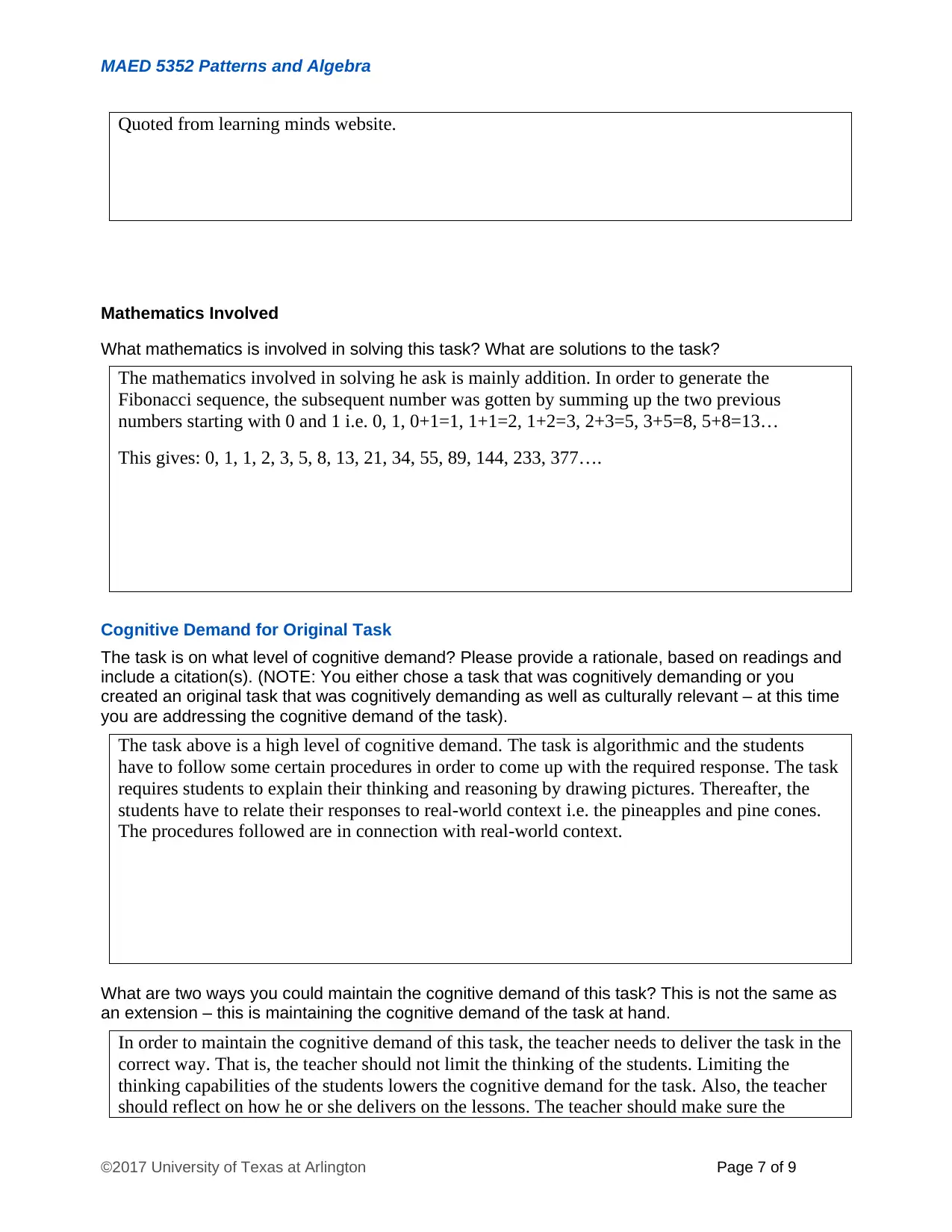
MAED 5352 Patterns and Algebra
Quoted from learning minds website.
Mathematics Involved
What mathematics is involved in solving this task? What are solutions to the task?
The mathematics involved in solving he ask is mainly addition. In order to generate the
Fibonacci sequence, the subsequent number was gotten by summing up the two previous
numbers starting with 0 and 1 i.e. 0, 1, 0+1=1, 1+1=2, 1+2=3, 2+3=5, 3+5=8, 5+8=13…
This gives: 0, 1, 1, 2, 3, 5, 8, 13, 21, 34, 55, 89, 144, 233, 377….
Cognitive Demand for Original Task
The task is on what level of cognitive demand? Please provide a rationale, based on readings and
include a citation(s). (NOTE: You either chose a task that was cognitively demanding or you
created an original task that was cognitively demanding as well as culturally relevant – at this time
you are addressing the cognitive demand of the task).
The task above is a high level of cognitive demand. The task is algorithmic and the students
have to follow some certain procedures in order to come up with the required response. The task
requires students to explain their thinking and reasoning by drawing pictures. Thereafter, the
students have to relate their responses to real-world context i.e. the pineapples and pine cones.
The procedures followed are in connection with real-world context.
What are two ways you could maintain the cognitive demand of this task? This is not the same as
an extension – this is maintaining the cognitive demand of the task at hand.
In order to maintain the cognitive demand of this task, the teacher needs to deliver the task in the
correct way. That is, the teacher should not limit the thinking of the students. Limiting the
thinking capabilities of the students lowers the cognitive demand for the task. Also, the teacher
should reflect on how he or she delivers on the lessons. The teacher should make sure the
©2017 University of Texas at Arlington Page 7 of 9
Quoted from learning minds website.
Mathematics Involved
What mathematics is involved in solving this task? What are solutions to the task?
The mathematics involved in solving he ask is mainly addition. In order to generate the
Fibonacci sequence, the subsequent number was gotten by summing up the two previous
numbers starting with 0 and 1 i.e. 0, 1, 0+1=1, 1+1=2, 1+2=3, 2+3=5, 3+5=8, 5+8=13…
This gives: 0, 1, 1, 2, 3, 5, 8, 13, 21, 34, 55, 89, 144, 233, 377….
Cognitive Demand for Original Task
The task is on what level of cognitive demand? Please provide a rationale, based on readings and
include a citation(s). (NOTE: You either chose a task that was cognitively demanding or you
created an original task that was cognitively demanding as well as culturally relevant – at this time
you are addressing the cognitive demand of the task).
The task above is a high level of cognitive demand. The task is algorithmic and the students
have to follow some certain procedures in order to come up with the required response. The task
requires students to explain their thinking and reasoning by drawing pictures. Thereafter, the
students have to relate their responses to real-world context i.e. the pineapples and pine cones.
The procedures followed are in connection with real-world context.
What are two ways you could maintain the cognitive demand of this task? This is not the same as
an extension – this is maintaining the cognitive demand of the task at hand.
In order to maintain the cognitive demand of this task, the teacher needs to deliver the task in the
correct way. That is, the teacher should not limit the thinking of the students. Limiting the
thinking capabilities of the students lowers the cognitive demand for the task. Also, the teacher
should reflect on how he or she delivers on the lessons. The teacher should make sure the
©2017 University of Texas at Arlington Page 7 of 9
Paraphrase This Document
Need a fresh take? Get an instant paraphrase of this document with our AI Paraphraser
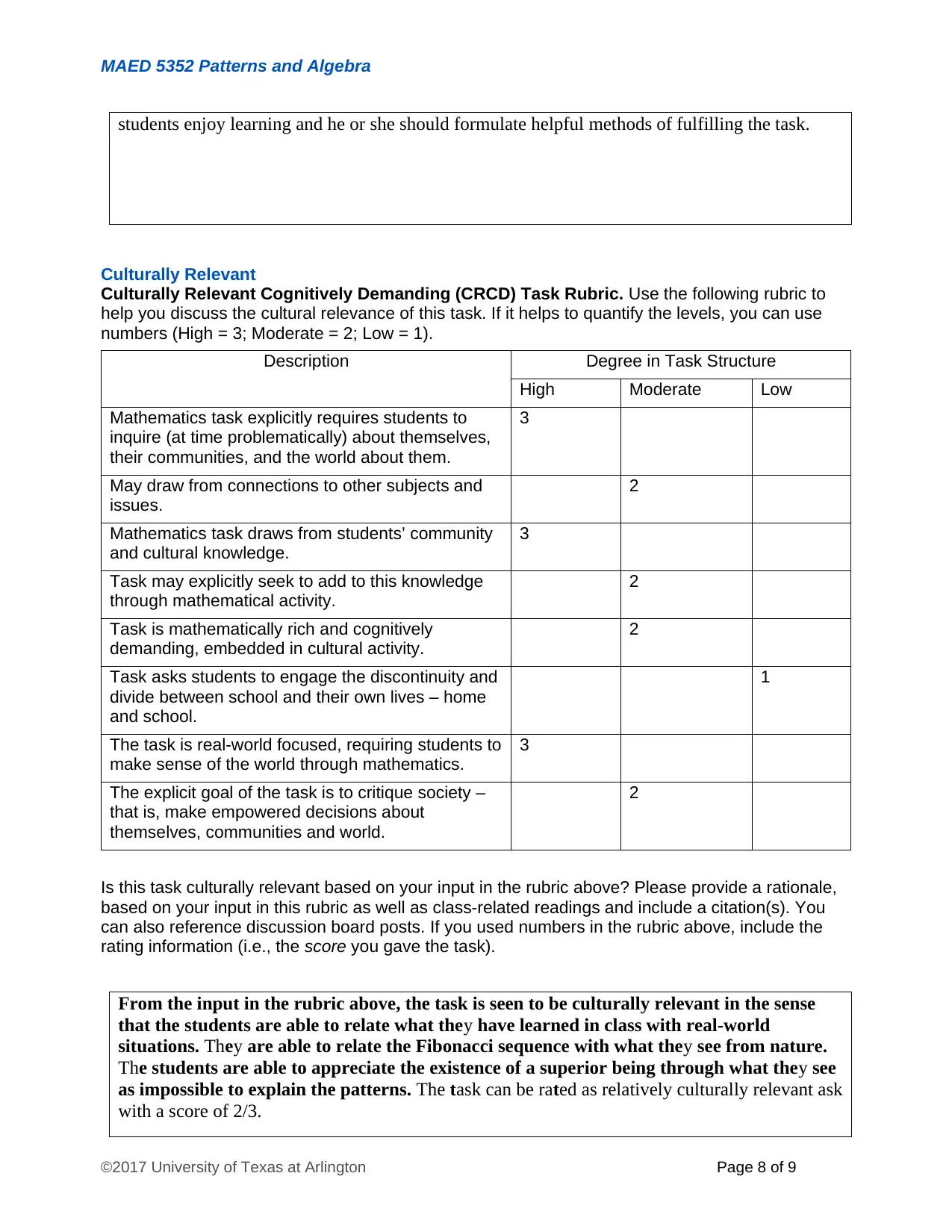
MAED 5352 Patterns and Algebra
students enjoy learning and he or she should formulate helpful methods of fulfilling the task.
Culturally Relevant
Culturally Relevant Cognitively Demanding (CRCD) Task Rubric. Use the following rubric to
help you discuss the cultural relevance of this task. If it helps to quantify the levels, you can use
numbers (High = 3; Moderate = 2; Low = 1).
Description Degree in Task Structure
High Moderate Low
Mathematics task explicitly requires students to
inquire (at time problematically) about themselves,
their communities, and the world about them.
3
May draw from connections to other subjects and
issues.
2
Mathematics task draws from students’ community
and cultural knowledge.
3
Task may explicitly seek to add to this knowledge
through mathematical activity.
2
Task is mathematically rich and cognitively
demanding, embedded in cultural activity.
2
Task asks students to engage the discontinuity and
divide between school and their own lives – home
and school.
1
The task is real-world focused, requiring students to
make sense of the world through mathematics.
3
The explicit goal of the task is to critique society –
that is, make empowered decisions about
themselves, communities and world.
2
Is this task culturally relevant based on your input in the rubric above? Please provide a rationale,
based on your input in this rubric as well as class-related readings and include a citation(s). You
can also reference discussion board posts. If you used numbers in the rubric above, include the
rating information (i.e., the score you gave the task).
From the input in the rubric above, the task is seen to be culturally relevant in the sense
that the students are able to relate what they have learned in class with real-world
situations. They are able to relate the Fibonacci sequence with what they see from nature.
The students are able to appreciate the existence of a superior being through what they see
as impossible to explain the patterns. The task can be rated as relatively culturally relevant ask
with a score of 2/3.
©2017 University of Texas at Arlington Page 8 of 9
students enjoy learning and he or she should formulate helpful methods of fulfilling the task.
Culturally Relevant
Culturally Relevant Cognitively Demanding (CRCD) Task Rubric. Use the following rubric to
help you discuss the cultural relevance of this task. If it helps to quantify the levels, you can use
numbers (High = 3; Moderate = 2; Low = 1).
Description Degree in Task Structure
High Moderate Low
Mathematics task explicitly requires students to
inquire (at time problematically) about themselves,
their communities, and the world about them.
3
May draw from connections to other subjects and
issues.
2
Mathematics task draws from students’ community
and cultural knowledge.
3
Task may explicitly seek to add to this knowledge
through mathematical activity.
2
Task is mathematically rich and cognitively
demanding, embedded in cultural activity.
2
Task asks students to engage the discontinuity and
divide between school and their own lives – home
and school.
1
The task is real-world focused, requiring students to
make sense of the world through mathematics.
3
The explicit goal of the task is to critique society –
that is, make empowered decisions about
themselves, communities and world.
2
Is this task culturally relevant based on your input in the rubric above? Please provide a rationale,
based on your input in this rubric as well as class-related readings and include a citation(s). You
can also reference discussion board posts. If you used numbers in the rubric above, include the
rating information (i.e., the score you gave the task).
From the input in the rubric above, the task is seen to be culturally relevant in the sense
that the students are able to relate what they have learned in class with real-world
situations. They are able to relate the Fibonacci sequence with what they see from nature.
The students are able to appreciate the existence of a superior being through what they see
as impossible to explain the patterns. The task can be rated as relatively culturally relevant ask
with a score of 2/3.
©2017 University of Texas at Arlington Page 8 of 9
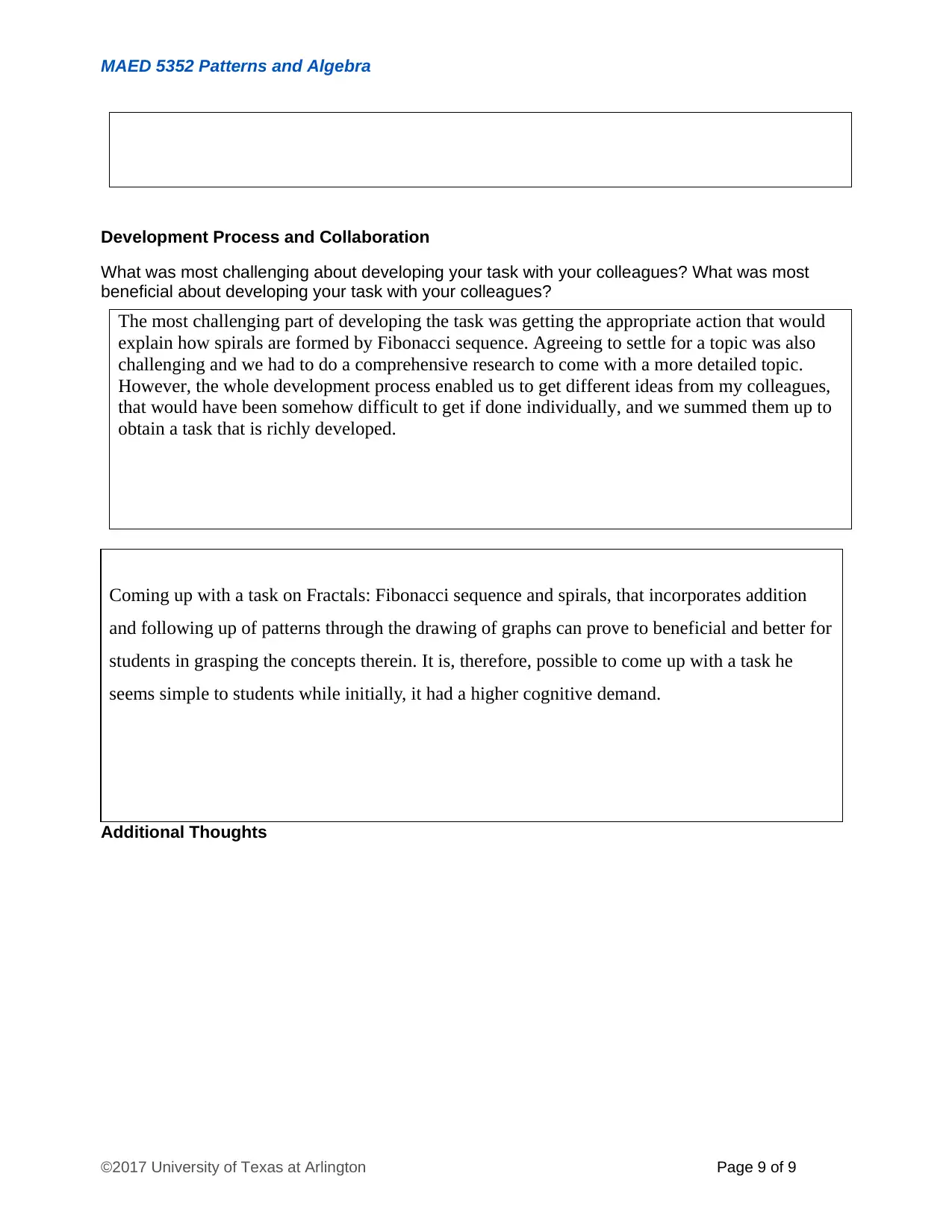
MAED 5352 Patterns and Algebra
Development Process and Collaboration
What was most challenging about developing your task with your colleagues? What was most
beneficial about developing your task with your colleagues?
The most challenging part of developing the task was getting the appropriate action that would
explain how spirals are formed by Fibonacci sequence. Agreeing to settle for a topic was also
challenging and we had to do a comprehensive research to come with a more detailed topic.
However, the whole development process enabled us to get different ideas from my colleagues,
that would have been somehow difficult to get if done individually, and we summed them up to
obtain a task that is richly developed.
Coming up with a task on Fractals: Fibonacci sequence and spirals, that incorporates addition
and following up of patterns through the drawing of graphs can prove to beneficial and better for
students in grasping the concepts therein. It is, therefore, possible to come up with a task he
seems simple to students while initially, it had a higher cognitive demand.
Additional Thoughts
©2017 University of Texas at Arlington Page 9 of 9
Development Process and Collaboration
What was most challenging about developing your task with your colleagues? What was most
beneficial about developing your task with your colleagues?
The most challenging part of developing the task was getting the appropriate action that would
explain how spirals are formed by Fibonacci sequence. Agreeing to settle for a topic was also
challenging and we had to do a comprehensive research to come with a more detailed topic.
However, the whole development process enabled us to get different ideas from my colleagues,
that would have been somehow difficult to get if done individually, and we summed them up to
obtain a task that is richly developed.
Coming up with a task on Fractals: Fibonacci sequence and spirals, that incorporates addition
and following up of patterns through the drawing of graphs can prove to beneficial and better for
students in grasping the concepts therein. It is, therefore, possible to come up with a task he
seems simple to students while initially, it had a higher cognitive demand.
Additional Thoughts
©2017 University of Texas at Arlington Page 9 of 9
1 out of 9
Your All-in-One AI-Powered Toolkit for Academic Success.
+13062052269
info@desklib.com
Available 24*7 on WhatsApp / Email
![[object Object]](/_next/static/media/star-bottom.7253800d.svg)
Unlock your academic potential
© 2024 | Zucol Services PVT LTD | All rights reserved.